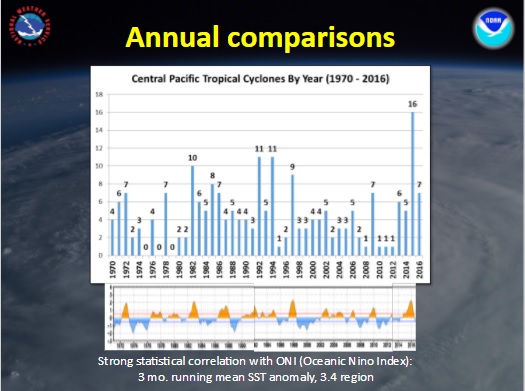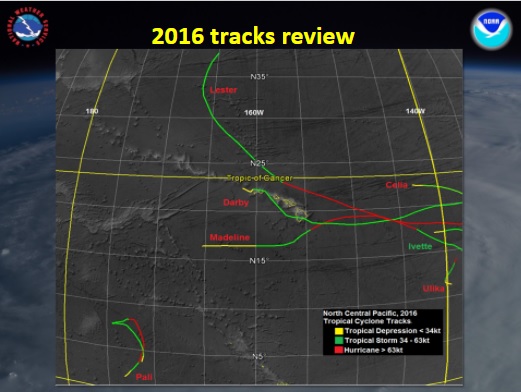5 to 8 Tropical Storms Expected this Hurricane Season
NOAA’s Central Pacific Hurricane Center today announced that climate conditions point to a near-to above-normal hurricane season in the Central Pacific basin this year.
For 2017, the outlook calls for a 40% chance of an above-normal season, a 40% chance of a near-normal season, and a 20% chance of a below-normal season, with 5 to 8 tropical cyclones expected to affect the Central Pacific.
An average season typically has 4-5 tropical cyclones, which include tropical depressions, tropical storms, and hurricanes.
“This outlook reflects the possible transition to a weak El Niño during the hurricane season, along with a prediction for near-or above-average ocean temperatures in the main hurricane formation region, and near- or weaker-than-average vertical wind shear in that same region,” said Gerry Bell, Ph.D., NOAA’s lead seasonal hurricane forecaster at the Climate Prediction Center.
He noted, “If El Niño develops, it may become strong enough to produce an above-normal season.”
El Niño decreases the vertical wind shear over the tropical central Pacific, which favors the development of more and stronger tropical cyclones. El Niño also favors more westward-tracking storms from the Eastern Pacific into the Central Pacific.
The outlook also says the Central Pacific basin may be shifting toward a longer-term period of increased tropical cyclone activity, in response to changes in global sea surface temperatures patterns in both the Atlantic and Pacific Ocean which historically last anywhere from 25-40 years.
The outlook is a general guide to the overall seasonal hurricane activity in the Central Pacific basin and does not predict whether, or how many, of these systems will affect Hawai‘i.
Hurricane season begins on June 1, and runs until November 30.
NOAA issued its Central Pacific hurricane outlook at a news conference in Honolulu, and urged Hawai‘i residents to be fully prepared before the hurricane season.
“The 2017 hurricane season marks the 25th anniversary of Hurricane Iniki, which brought life-changing impacts that have lasted more than a generation,” said Chris Brenchley, director of NOAA’s Central Pacific Hurricane Center. “Considering the devastation we saw from Iniki, as well as the more recent impacts from Hurricane Iselle and Tropical Storm Darby, I remind everyone that now is the time to make sure you and your family are prepared for hurricane season. Become weather-ready by signing up for weather alerts, developing and practicing a family emergency plan, and building an emergency kit before hurricane season begins.”
“We all need to plan and prepare right now for the upcoming hurricane season, which could become the third above-normal season in row,” said Bell. “Make sure your structure will withstand the tremendous force of a hurricane. Know where you will go and what you will take with you should an evacuation be necessary. Ensure that you have adequate insurance. Practice your plan, ensure you have a way to get the latest official forecast and emergency information, and assemble the supplies you might need. Doing these things now will ensure we will all be weather-ready and disaster resilient well before the storms threaten.”
The Federal Emergency and Management Administration has a website, which provides information on the basics of each type of hurricane hazard, how to protect yourself and your property, and what steps to take now.
The Central Pacific Hurricane Center continuously monitors weather conditions, employing a network of satellites, land- and ocean-based sensors and aircraft reconnaissance missions operated by NOAA and its partners. This array of data supplies the information for complex computer modeling and human expertise that serves as the basis for the hurricane center’s track and intensity forecasts that extend out five days.
The seasonal hurricane outlook is produced in collaboration with NOAA’s Climate Prediction Center – a division of the National Weather Service.
NOAA provided a Dry season (May through September) outlook stating:
NOAA Climate Prediction Center’s forecast probabilities favor above normal precipitation during the first half of the dry season.
Wet conditions will mainly affect the windward slopes and the Kona slopes on the Big Island.
Leeward areas (other than Kona) are forecasted to be seasonally dry.
o Expecting an expansion of existing drought or the development of new leeward drought areas.
o Normal brush fire season expected for leeward areas.
Wet season statistics
Overall: 14th wettest wet season in the last 30 years (average rankings from 8 sites)
Big Island
o Most windward sites near average despite erratic wet season.
o Leeward sites mostly from 60 to 90% of average.
o Hilo Airport: 76.54 inches, 15th wettest wet season.



















